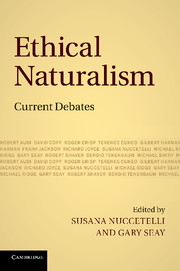Book contents
- Frontmatter
- Contents
- Contributors
- Introduction
- Chapter 1 Naturalism in moral philosophy
- Chapter 2 Normativity and reasons: five arguments from Parfit against normative naturalism
- Chapter 3 Naturalism: feel the width
- Chapter 4 On ethical naturalism and the philosophy of language
- Chapter 5 Metaethical pluralism: how both moral naturalism and moral skepticism may be permissible positions
- Chapter 6 Moral naturalism and categorical reasons
- Chapter 7 Does analytical moral naturalism rest on a mistake?
- Chapter 8 Supervenience and the nature of normativity
- Chapter 9 Can normativity be naturalized?
- Chapter 10 Ethical non-naturalism and experimental philosophy
- Chapter 11 Externalism, motivation, and moral knowledge
- Chapter 12 Naturalism, absolutism, relativism
- Bibliography
- Index
Chapter 3 - Naturalism: feel the width
Published online by Cambridge University Press: 05 January 2012
- Frontmatter
- Contents
- Contributors
- Introduction
- Chapter 1 Naturalism in moral philosophy
- Chapter 2 Normativity and reasons: five arguments from Parfit against normative naturalism
- Chapter 3 Naturalism: feel the width
- Chapter 4 On ethical naturalism and the philosophy of language
- Chapter 5 Metaethical pluralism: how both moral naturalism and moral skepticism may be permissible positions
- Chapter 6 Moral naturalism and categorical reasons
- Chapter 7 Does analytical moral naturalism rest on a mistake?
- Chapter 8 Supervenience and the nature of normativity
- Chapter 9 Can normativity be naturalized?
- Chapter 10 Ethical non-naturalism and experimental philosophy
- Chapter 11 Externalism, motivation, and moral knowledge
- Chapter 12 Naturalism, absolutism, relativism
- Bibliography
- Index
Summary
1. Certain claims we make, such as that someone has a reason to act in some way, that some action was wrong or cruel, or that a painting is great or poignant, may be taken to imply normative or evaluative facts or properties. A question then arises concerning the metaphysical status of these facts or properties. Many philosophers have been inclined towards so-called “naturalistic” answers to this question. There are many kinds of naturalism and hence of non-naturalism. Often the gulf between the two positions is clearly unbridgeable. Consider for example a naturalist who advocates an extreme form of normative and evaluative nihilism: there are no normative evaluative facts or properties, and we should stop talking as if there were, since such talk can be debunked by, say, some version of evolutionary expressivism. None of those who have described themselves as non-naturalists could be brought to accept such a view. But there are more capacious forms of naturalism, and my aim in this paper is to suggest that, if we uncover what motivates naturalism and its denial, we can find a version of naturalism broad enough to be plausible to those initially attracted to non-naturalism.
2. Before discussing those motivations, let me first narrow the focus a little.
- Type
- Chapter
- Information
- Ethical NaturalismCurrent Debates, pp. 58 - 69Publisher: Cambridge University PressPrint publication year: 2011
- 1
- Cited by



